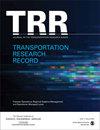Shared E-Scooter User Characteristics and Usage Patterns across Four U.S. Cities
IF 1.8
4区 工程技术
Q3 ENGINEERING, CIVIL
引用次数: 0
Abstract
The rapid growth of shared e-scooters around the world creates an interest and a need to understand who uses shared e-scooters, trip patterns, and modal shift impacts. To shed light on these questions, this study conducted an online survey ( N = 1498) to collect information on shared e-scooter use in four U.S. cities: Birmingham, AL, Washington D.C., Los Angeles, CA, and Miami, FL. The paper provides a comprehensive view of shared e-scooter use in different cities and reveals the similarities and differences in e-scooter users’ socioeconomic characteristics. Furthermore, the results of a binary logistic model show the impact of socioeconomic and travel modal choice factors on predicting shared e-scooter usage. The findings suggest that male, younger, and more affluent users who live in smaller households owning fewer vehicles are more likely to use shared e-scooter services. The relationships between income level, race/ethnicity, or e-scooter ownership and the usage of shared e-scooters are not statistically significant. The McFadden’s R 2 of the binary logistic regression model indicates an excellent fit. The results also show that compared with non-users, shared e-scooter users tend to assess travel cost as more important and travel safety as less important in their mode choice. The findings from this work can help city planners, policymakers, and other micromobility stakeholders in their efforts to promote the adoption of shared e-scooters and improve on deployment practices of shared e-scooters at their locations.美国四个城市共享电动滑板车用户特征和使用模式
共享电动滑板车在全球范围内的快速增长,引发了人们对了解谁在使用共享电动滑板车、出行模式和模式转换影响的兴趣和需求。为了阐明这些问题,本研究进行了一项在线调查(N = 1498),收集了四个美国城市的共享电动滑板车使用信息:伯明翰,AL,华盛顿特区,洛杉矶,CA和迈阿密,FL。本文提供了不同城市共享电动滑板车使用的综合视图,并揭示了电动滑板车用户社会经济特征的异同。此外,二元logistic模型的结果显示了社会经济因素和出行方式选择因素对预测共享电动滑板车使用情况的影响。研究结果表明,家庭规模较小、车辆较少的男性、年轻、富裕用户更有可能使用共享电动滑板车服务。收入水平、种族/民族或电动滑板车所有权与共享电动滑板车的使用之间的关系在统计上不显著。二元logistic回归模型的McFadden’s r2表明拟合很好。结果还表明,与非共享电动滑板车用户相比,共享电动滑板车用户在选择出行方式时更看重出行成本,而出行安全则不那么重要。这项工作的发现可以帮助城市规划者、政策制定者和其他微型交通利益相关者努力促进共享电动滑板车的采用,并改善共享电动滑板车在其所在地的部署实践。
本文章由计算机程序翻译,如有差异,请以英文原文为准。
求助全文
约1分钟内获得全文
求助全文
来源期刊

Transportation Research Record
工程技术-工程:土木
CiteScore
3.20
自引率
11.80%
发文量
918
审稿时长
4.2 months
期刊介绍:
Transportation Research Record: Journal of the Transportation Research Board is one of the most cited and prolific transportation journals in the world, offering unparalleled depth and breadth in the coverage of transportation-related topics. The TRR publishes approximately 70 issues annually of outstanding, peer-reviewed papers presenting research findings in policy, planning, administration, economics and financing, operations, construction, design, maintenance, safety, and more, for all modes of transportation. This site provides electronic access to a full compilation of papers since the 1996 series.
 求助内容:
求助内容: 应助结果提醒方式:
应助结果提醒方式:


